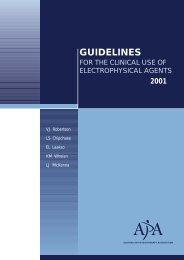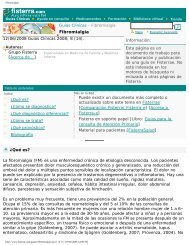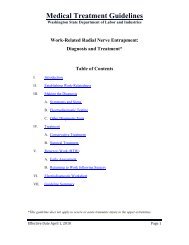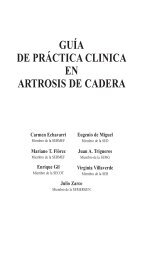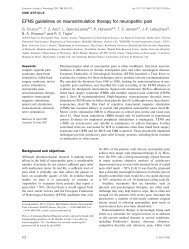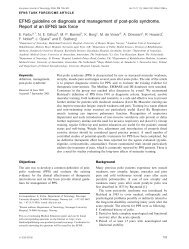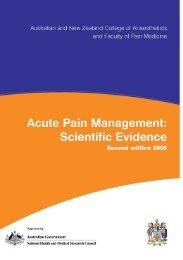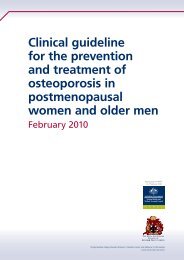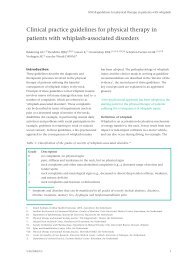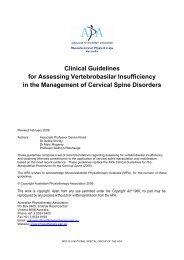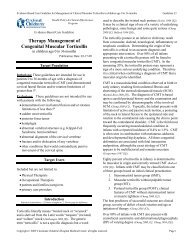Practice Parameter and Literature Review of the Usefulness of ...
Practice Parameter and Literature Review of the Usefulness of ...
Practice Parameter and Literature Review of the Usefulness of ...
You also want an ePaper? Increase the reach of your titles
YUMPU automatically turns print PDFs into web optimized ePapers that Google loves.
<strong>Practice</strong> <strong>Parameter</strong>: Carpal Tunnel Syndromeconduction along <strong>the</strong> ring finger in normal subjects <strong>and</strong> in patientswith a carpal tunnel syndrome. Electroencephalogr Clin Neurophysiol1991;81(1):18-23. Criteria Met (5/6: 1,3,4,5,6) Source: MedlineSearch. Abstract: With stimulation <strong>of</strong> <strong>the</strong> ring finger using ringelectrodes <strong>and</strong> needle electrode recording with averaging at <strong>the</strong> wristover <strong>the</strong> median <strong>and</strong> ulnar nerves, DSLs <strong>and</strong> median-ulnar differenceswere recorded in 23 normal volunteers <strong>and</strong> 38 CTS patients. Theirfindings suggest that <strong>the</strong> median-ulnar orthodromic DSL differencefrom <strong>the</strong> ring finger was a useful screening technique in <strong>the</strong> diagnosis<strong>of</strong> CTS, but did not identify every patient when compared tostimulation <strong>of</strong> thumb <strong>and</strong>/or middle finger.144. Lesser EA, Venkatesh S, Preston DC, Logigian EL. Stimulation distalto <strong>the</strong> lesion in patients with carpal tunnel syndrome. Muscle Nerve1995;18:503-507. Criteria Met (5/6: 1,3,4,5,6) Source: MedlineSearch. Abstract: In CTS patients, a low amplitude median CMAP orSNAP with stimulation at <strong>the</strong> wrist crease (proximal to <strong>the</strong> carpaltunnel) is due to ei<strong>the</strong>r demyelination or axonal degeneration or both.With axonal degeneration, <strong>the</strong> amplitude <strong>of</strong> <strong>the</strong> CMAP <strong>and</strong> SNAP is<strong>the</strong> same with stimulation above <strong>and</strong> below <strong>the</strong> site <strong>of</strong> <strong>the</strong> pathology.With focal demyelination, <strong>the</strong> amplitude <strong>of</strong> <strong>the</strong> CMAP <strong>and</strong> SNAP isgreater with stimulation below compared to stimulation above <strong>the</strong> site<strong>of</strong> <strong>the</strong> pathology. Of 59 consecutive CTS patient h<strong>and</strong>s, 36 (61%)showed significant reduction in CMAP <strong>and</strong>/or antidromic SNAPamplitudes with stimulation at <strong>the</strong> wrist compared to stimulation at<strong>the</strong> palm which indicated <strong>the</strong> presence <strong>of</strong> focal demyelinationresulting in conduction block <strong>and</strong>/or pathologic dispersion with phasecancellation. We conclude that in patients with CTS, as in o<strong>the</strong>rentrapment neuropathies, stimulation both proximal <strong>and</strong> distal to <strong>the</strong>carpal tunnel provides important information about <strong>the</strong> median nervepathology in <strong>the</strong> carpal tunnel.145. Lew HL, Wang L, Robinson LR. Test-retest reliability <strong>of</strong> combinedsensory index: implications for diagnosing carpal tunnel syndrome.Muscle Nerve 2000;23: 1261-1264. Criteria Met (5/6: 1,2,3,5,6).Source: Medline Search. Abstract: Robinson <strong>and</strong> colleagues (1998)previously showed that, compared to a single NCS, <strong>the</strong> combinedsensory index (CSI) has superior sensitivity <strong>and</strong> specificity for <strong>the</strong>diagnosis <strong>of</strong> CTS. This prospective study evaluated <strong>the</strong> test-retestreliability <strong>of</strong> a single NCS versus <strong>the</strong> CSI by <strong>the</strong> same examiner inone h<strong>and</strong> <strong>of</strong> 32 subjects: 26 normal subjects <strong>and</strong> 6 CTS patients. In asubgroup <strong>of</strong> 18 subjects, <strong>the</strong> study evaluated <strong>the</strong> effect <strong>of</strong> temperatureon absolute latencies <strong>and</strong> latency differences derived from sensoryNCS. CSI had <strong>the</strong> highest test re-test reliability <strong>and</strong> <strong>the</strong> CSI score (<strong>the</strong>sum <strong>of</strong> 3 latency differences) was less affected by temperaturechanges than absolute latency values <strong>of</strong> individual NCSs.146. Logigian EL, Busis NA, Berger AR, Bruynincky F, Khalil N, ShahaniBT, Young RR, Lumbrical sparing in carpal tunnel syndrome:anatomic, physiologic, <strong>and</strong> diagnostic implications. Neurology1987;37:1499-1505. Criteria Met (5/6: 1,3,4,5,6) Source: MedlineSearch. Abstract: With stimulation at <strong>the</strong> wrist, simultaneousrecording <strong>of</strong> CMAP to <strong>the</strong> second lumbrical <strong>and</strong> APB were recordedin 61 patients with CTS (as defined by electrophysiologic criteria) <strong>and</strong>in 16 normal subjects. They found that <strong>the</strong> lumbrical distal latencywas relatively spared when compared to <strong>the</strong> distal latency to <strong>the</strong> APB<strong>and</strong> that this may be a sensitive test that could be used in addition too<strong>the</strong>r tests for <strong>the</strong> diagnosis <strong>of</strong> CTS. They also found that it was notspecific for CTS since it occasionally was abnormal in more proximallesions <strong>of</strong> <strong>the</strong> median nerve.147. Loong SC. The carpal tunnel syndrome: a clinical <strong>and</strong>electrophysiological study <strong>of</strong> 250 patients. Proc Aust Assoc Neurol1977;14:51-62. Criteria Met (3/6: 1,2,6) Source: Holmgren, 1987.148. Loong SC, Seah CS. Comparison <strong>of</strong> median <strong>and</strong> ulnar sensory nerveaction potentials in <strong>the</strong> diagnosis <strong>of</strong> <strong>the</strong> carpal tunnel syndrome. JNeurol Neurosurg Psychiatry 1971;34:750-754. Criteria Met (5/6:1,2,3,5,6) Source: Macleod, 1987. Abstract: With stimulation at <strong>the</strong>index <strong>and</strong> little fingers <strong>and</strong> recording at <strong>the</strong> wrist over <strong>the</strong> median <strong>and</strong>ulnar nerves, DSL <strong>and</strong> SNAP amplitudes were recorded in 30 healthyfemale subjects <strong>and</strong> 22 h<strong>and</strong>s in 15 CTS patients. They found that <strong>the</strong>median-to-ulnar SNAP amplitude ratio <strong>of</strong> less than 1 was a sensitivetest in <strong>the</strong> diagnosis <strong>of</strong> CTS <strong>and</strong> particularly useful in patients whoshowed a normal DML <strong>and</strong> DSL.149. *Louis DS, Hankin FM. Symptomatic relief following carpal tunneldecompression with normal electroneuromyographic studies(notification <strong>of</strong> retraction by Hankin <strong>and</strong> Louis in two subsequentissues: Orthopedics 1988;11:532 <strong>and</strong> Orthopedics 1988;11:1244).Orthopedics 1987;10:434-436. Criteria Met (1/6: 2) Source: MedlineSearch.150. *Luchetti R, Schoenhuber R, L<strong>and</strong>i A. Localized nerve damagerecorded intraoperatively in carpal tunnel syndrome. ElectromyogrClin Neurophysiol 1988;28:379-383. Criteria Met (3/6: 1,3,5) Source:Medline Search.151. *Luchetti R, Schoenhuber R, Nathan P. Correlation <strong>of</strong> segmentalcarpal tunnel pressures with changes in h<strong>and</strong> <strong>and</strong> wrist positions inpatients with carpal tunnel syndrome <strong>and</strong> controls. J H<strong>and</strong> Surg [Br ]1998;23:598-602. Criteria Met (3/6: 1,2,5) Source: Medline Search.Abstract: The authors investigated pressures with an endoscopicpressure monitor at 1 cm intervals along <strong>the</strong> carpal tunnel in 39patients with CTS <strong>and</strong> 12 controls. Pressures were measured forrelaxed <strong>and</strong> gripping h<strong>and</strong> positions in combination with neutral,extended, <strong>and</strong> flexed wrist positions. The study confirmed previousreports that CT pressures are generally higher in CTS patients thancontrols, <strong>and</strong> that intratunnel pressures are generally increased withwrist extension in comparison with wrist flexion. Maximumintratunnel pressures were generally found in <strong>the</strong> central part <strong>of</strong> <strong>the</strong>tunnel <strong>and</strong> minimum pressures in <strong>the</strong> distal tunnel. Gripping h<strong>and</strong>pressures in <strong>the</strong> tunnel were lowest with <strong>the</strong> wrist flexed. In bothcontrols <strong>and</strong> CTS patients, only in <strong>the</strong> neutral wrist <strong>and</strong> relaxed h<strong>and</strong>positions were pressures highest at <strong>the</strong> point where nerve conductionstudies have indicated <strong>the</strong> nerve is most likely to be compromised (in<strong>the</strong> midpalm just distal to <strong>the</strong> distal margin <strong>of</strong> <strong>the</strong> carpal tunnel).152. Lundborg G, Gelberman RH, Minteer-Convery M, Lee YF, HargensAR. Median nerve compression in <strong>the</strong> carpal tunnel ⎯ functionalresponse to experimentally induced controlled pressure. J H<strong>and</strong> Surg1982;7:252-259. Background Reference. Source: AAEM 2000 CTSTask Force member.153. Lundborg G, Lie-Stenstrom AK, Sollerman C, Stromberg T, PyykkoI. Digital vibrogram: a new diagnostic tool for sensory testing incompression neuropathy. J H<strong>and</strong> Surg Am 1986;11:693-699. CriteriaMet (3/6: 1,2,3) Source: Medline Search.154. *Macdonald G, Robertson MM, Erickson JA. Carpal tunnel syndromeamong California dental hygienists. Dent Hyg (Chic) 1988;62:322-327. Criteria Met (2/6: 1,2) Source: Medline Search.155. *Macdonell RA, Schwartz MS, Swash M. Carpal tunnel syndrome:Which finger should be tested? An analysis <strong>of</strong> sensory conduction indigital branches <strong>of</strong> <strong>the</strong> median nerve. Muscle Nerve 1990;13:601-606.Criteria Met (3/6: 1,2,3) Source: Medline Search.156. *MacLean IC, Sik Cho D. Carpal tunnel syndrome: a comparison <strong>of</strong>distal sensory latencies <strong>of</strong> median <strong>and</strong> radial nerves. Muscle Nerve1981;4:444. Criteria Met (0/6) (Abstract Only) Source: Rivner, 1991.157. Macleod WN: Repeater F-waves: a comparison <strong>of</strong> sensitivity withsensory antidromic wrist-to-palm latency <strong>and</strong> distal motor latency in<strong>the</strong> diagnosis <strong>of</strong> carpal tunnel syndrome. Neurology 1987;37:773-778.Criteria Met (4/6: 1,3,5,6) Source: Medline Search. Abstract: Withstimulation at <strong>the</strong> wrist <strong>and</strong> recording <strong>of</strong> F waves over <strong>the</strong> APB, <strong>the</strong>frequency <strong>of</strong> repeater F waves (identical recurring F waves in latency,configuration, <strong>and</strong> amplitude) was determined by measuring 100supramaximal shocks; 209 healthy h<strong>and</strong>s <strong>and</strong> 147 entrapped mediannerves were evaluated. The repeater F waves was compared to <strong>the</strong>sensory 1 cm DSL inching latency across <strong>the</strong> wrist. A high percentrepeater F-wave value was considered indicative <strong>of</strong> CTS <strong>and</strong> <strong>the</strong>sensitivity approaches that <strong>of</strong> <strong>the</strong> sensory antidromic inchingtechnique across <strong>the</strong> carpal tunnel.158. Marin EL, Vernick S, Friedmann LW. Carpal tunnel syndrome:Median nerve stress test. Arch Phys Med Rehabil 1983;64:206-208.Criteria Met (5/6: 1,2,3,5,6) Source: Borg, 1986. Abstract: Withmedian stimulation at <strong>the</strong> wrist <strong>and</strong> recording over <strong>the</strong> APB <strong>and</strong> ringelectrodes to <strong>the</strong> index finger, DML <strong>and</strong> DSL were obtained from <strong>the</strong>median nerve in <strong>the</strong> neutral position, <strong>the</strong>n in extreme tolerableextension at 5 minutes <strong>and</strong> 10 minutes followed by <strong>the</strong> testing in <strong>the</strong>extreme tolerable flexion position after 5 <strong>and</strong> 10 minutes. An orthosiswas devised to enable <strong>the</strong> wrist to be held in extreme tolerableextension which ranged from 45E-85E <strong>and</strong> extreme tolerable flexionwhich ranged from 45E-90E. Fourteen h<strong>and</strong>s in 14 patients who hadCTS <strong>and</strong> 12 h<strong>and</strong>s from 12 volunteers were evaluated. Of <strong>the</strong> 14patients, 5 <strong>of</strong> <strong>the</strong>se had normal DSL <strong>and</strong> DML latencies in <strong>the</strong> neutralposition. Three <strong>of</strong> <strong>the</strong>se 5 showed an increase in DSL from <strong>the</strong> upperrange <strong>of</strong> normal to above normal following extension or flexion.S968 CTS <strong>Literature</strong> <strong>Review</strong>© 2002 American Association <strong>of</strong> Electrodiagnostic Medicine



